Tag Archives: Asian carp
“Thar’s gold in them thar gills!” Why this Peoria fish company wants to come to Pekin
 Many central Illinois residents see Asian carp as an invasive species and a hazard to public waterways. But a wholesale and retail fresh water fish processing company sees them as an opportunity and wants to set up a facility in Pekin. Vogel noted that commercial fishermen have been netting carp on the Illinois River for “quite a few years.” While those fishermen have always had access to carp processing plants, he believes Freshwater Solutions proposed Pekin facility can potentially operate on a larger scale. “It’s not just the Asian carp we’re targeting,” he said. “It’s all freshwater species in commercial fishing. What we’re trying to do is build an old industry anew right here in central Illinois.” more, >>click to read<< 08:06
Many central Illinois residents see Asian carp as an invasive species and a hazard to public waterways. But a wholesale and retail fresh water fish processing company sees them as an opportunity and wants to set up a facility in Pekin. Vogel noted that commercial fishermen have been netting carp on the Illinois River for “quite a few years.” While those fishermen have always had access to carp processing plants, he believes Freshwater Solutions proposed Pekin facility can potentially operate on a larger scale. “It’s not just the Asian carp we’re targeting,” he said. “It’s all freshwater species in commercial fishing. What we’re trying to do is build an old industry anew right here in central Illinois.” more, >>click to read<< 08:06
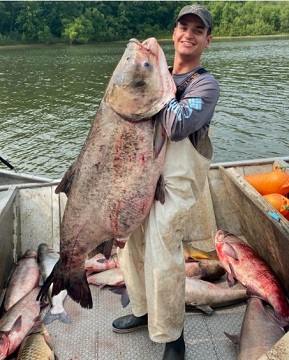
“Largest bighead carp we’ve caught:” Commercial fisherman snags massive fish in Illinois
A commercial fisherman scouring the backwaters of the Illinois River last week may have caught more than he bargained for when a massive bighead carp lodged itself in his net. What’s more surprising, it was the second fish in as many days with a weight hovering around the 100-pound mark that Charlie Gilpin Jr. hauled in while fishing the same waters. Gilpin reportedly caught the gigantic bighead carp on Thursday, June 15 — one day after he caught a 90-pounder in the same area, said Jason DeBoer, a larger river fisheries ecologist with the Illinois River Biological Station, a monitoring and research facility. >click to read< 11:50
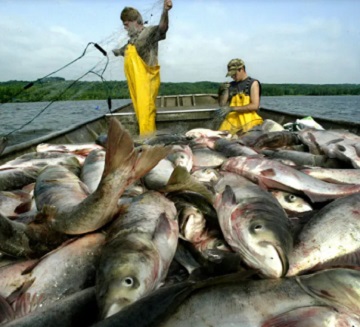
Inland Fisheries: Can Illinois turn Asian carp into Chilean sea bass? State to announce new name
A new name for the much-maligned fish will be announced Wednesday by state officials who hope the rebrand will shed the negative image of a muddy tasting bottom-feeder and inject the truth — they’re top-feeding plankton eaters that taste quite good. The “Big Reveal” will be hosted by the Illinois Department of Natural Resources,,, State officials hope the rebrand will lead to more people eating the fish, which would lead to more commercial fishing operations to pull them from the Illinois River and, ultimately, decrease their numbers and the risk that Asian carp could eventually make their way into the Great Lakes. >click to read< 17:37
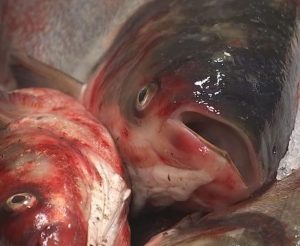
Ribbon Cut on Aurora Facility for Asian Carp Processing
New England faces a 70 million pound lobster bait shortage this year and the bait problem isn’t going away – neither are the invasive Asian Carp on Kentucky and Barkley Lakes. Brian Colgan founded Colgan Carp Solutions to provide a private sector answer to the Asian Carp problem. Their business models Asian Carp into a sought-after commodity with opportunities for entry into various markets. From bait to fertilizer, pet food and human consumption…there are numerous entry points for Asian Carp. To start, Colgan is turning Asian Carp into Lobster Bait. >click to read< 09:31
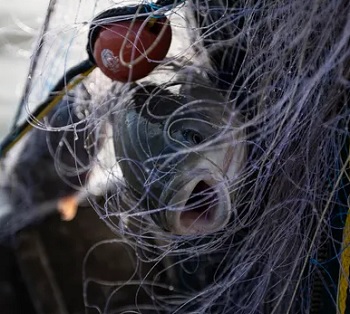
“The Perfect Catch” campaign: Asian carp is getting a new name and a public makeover
Illinois officials and their partners want to give the invasive Asian carp threatening the Great Lakes a similar makeover. The goal: To grow the fish’s image as a healthy, delicious, organic, sustainable food source which will in turn, get more fishermen removing more tons of the fish from Illinois rivers just outside of Lake Michigan. Markets such as pet food, bait and fertilizer have expanded the use of invasive Asian carp in recent years. But “it’s been hard to get the human consumption part of this because of the four-letter word: carp,” A full-on media blitz is coming later this year to change that. >click to read< 09:51

Inland Fish Fight: Invasive Asian carp threaten Kansas and Missouri waterways
Common carp, which resemble overgrown goldfish, were imported from Europe, where they were popular sportfish and table fare over 150 years ago. But bighead and silver carp were first brought from Asia about 50 years ago, Chapman said. Being plankton eaters, the carp were imported with the hope they could clean waters of unwanted materials, including sewage lagoons. It didn’t work out that way. “There’s never been a fish brought in for large-scale aquaculture that hasn’t escaped into the wild,” Chapman said. “Somebody wasn’t paying attention.” >click to read< 10:47
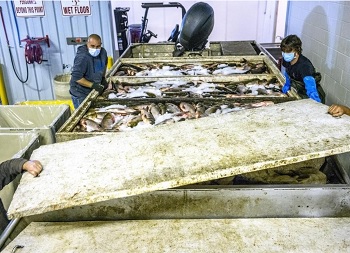
East Peoria businessman aims to take a bite out of Asian carp population in Illinois River
They worked all day on the Illinois River, tracking carp, casting nets and hauling the catch of the day into their 30-foot johnboats. By late afternoon, the fishermen had docked at different marinas located up and down the state’s arterial waterway, their boats heavy with thousands of pounds of dead and dying buffalo, bighead, silver and grass carp. Next, they trailered their boats behind heavy-duty pickup trucks and then drove one, two, three hours to a fish plant somewhere to sell their day’s work and to empty their loads so they could drive back home and prepare to fish another day. Usually, the next day.,,, >click to read< 11:51
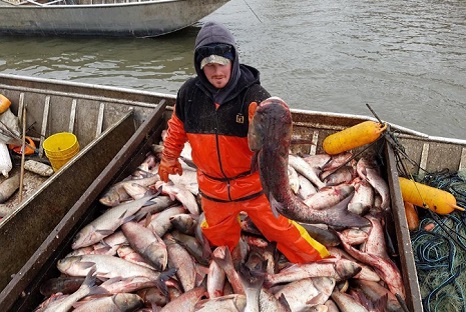
Asian carp processing facility might be headed to North Peoria
A former government adviser and official, Brian Colgan, leads a company that intends to convert a 4,000-square-foot building at 8606 N. Pioneer Road into an Asian carp processing, packaging and distribution facility. There the fish would be fashioned into bait for domestic crab, crawfish and lobster harvesters on all coasts. “Our company, Colgan Carp Solutions Inc., by creating these markets and working with others in the area who want to do the same, can drive up demand, can reduce the population in the Illinois River and hopefully create some jobs, economic opportunity and show that there’s a market-driven strategy for invasive-species management,” Colgan said. >click to read< 11:33
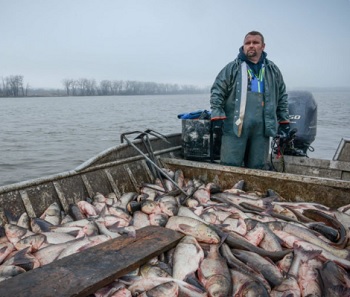
Carpe Carp
Clint Carter’s first catch of the day jumps right into his boat before he’s laid an inch of net. Another four or five silver carp make the leap in the time it takes Carter and his partner, Dave Buchanan, to scout out the best fishing grounds on that morning’s stretch of the Illinois River. The motor of their  steel-sided skiff startles the silvers enough to send them shooting out of the water in unpredictable parabolas. The motor of their steel-sided skiff startles the silvers enough to send them shooting out of the water in unpredictable parabolas. Once the men near a dense shoal of fish, the commotion reaches a fever pitch, like popcorn in a hot pan. Buchanan strategically twists and turns the boat, as Carter lets hundreds of yards of trammel nets off the stern. >click to read, photos< 13:46
steel-sided skiff startles the silvers enough to send them shooting out of the water in unpredictable parabolas. The motor of their steel-sided skiff startles the silvers enough to send them shooting out of the water in unpredictable parabolas. Once the men near a dense shoal of fish, the commotion reaches a fever pitch, like popcorn in a hot pan. Buchanan strategically twists and turns the boat, as Carter lets hundreds of yards of trammel nets off the stern. >click to read, photos< 13:46
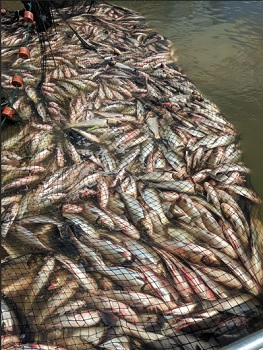
Asian Carp Fishing Method Being Tested In Kentucky
A commercial fisherman harvested close to 60,000 pounds of Asian carp from one bay in 48 hours as part of a fishing method being tested in Kentucky for the first time. Often referred to as either haul seining or beach seining, the method involves running a net out into the bay and scooping fish to the bank, hauling the net in with a winch and by hand. Wade Robbins, owner of Robbins Fishery, conducted the test in Kentucky Lake’s Pisgah Bay from the afternoon of March 19 to the morning of March 21. “It’s new in Kentucky,” Robbins said. “It’s been used for probably a century. It’s been perfected by the guys out of Browning, Ill., to use for Asian carp.” >click to read< 12:57

Asian Carp: Chinese investment and wisdom rescue Kentucky’s fisheries
As New Year 2020 nears, 62-year-old Angie Yu is marketing her fish products harder than usual. The Chinese American businesswoman views the holiday season as a prime opportunity for the delicacies to gain wider popularity.The entrepreneur prides herself on her choice of location. As the name Two Rivers Fisheries indicates, her plant sits on the confluence of two rivers-the Mississippi and its major tributary, the Ohio., After receiving carp from local fishermen, the plant processes, flash-freezes and boxes up the fish before shipping them out to destinations across the globe. >click to read< 10:15
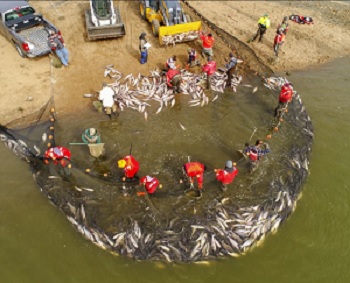
Asian carp: Turning a nuisance into a commodity for the Great Lakes
One of the great myths about Asian carp is that the war against them will be won if the Great Lakes region succeeds in keeping them out of Lake Michigan. Indeed the stakes are high in that part of the Midwest, including in communities that wrap around the fertile fishing waters of Lake Erie’s western basin, and the rivers that feed into the lake.,, But the Great Lakes are the site of only one battle in the Asian carp war, and environmental experts contend there is no apparent end in sight to what has evolved over several decades into a slow-moving biological disaster cutting across the heart of North America, Video, photo’s, >click to read< 17:20
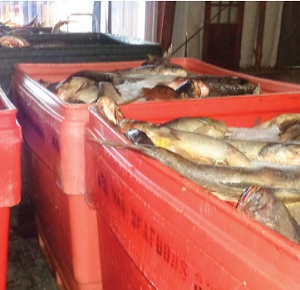
Industrial Park Will Be Dedicated To Processing Asian Carp
Construction on Ballard County, Ky.’s new International Fisheries Industrial Park is underway, with four Chinese companies that process Asian carp having already closed on lots. Two more companies have signed agreements, with sales of those lots expected to be finalized soon. The sales create the first commercial park dedicated to the processing of Asian carp anywhere in the United States. “It’s really neat to see how all of this has played out,” Ballard County Judge-Executive Todd Cooper said. >click to read< 15:32
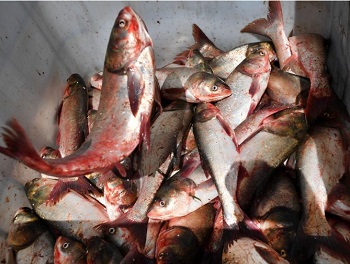
U.S. Senate’s proposed $14 million funding increase to fight Asian carp not matched in House budget
Last month, the Senate Committee on Appropriations approved a funding bill that included $25 million for Asian carp management, a $14 million increase from last year. That money would go to the U.S. Fish and Wildlife Service to be divided nationally for areas dealing with the fish. At the time, U.S. Sen. Lamar Alexander, R-Tenn., was hopeful the bill would give areas including Tennessee more resources to deal with the threat.,, The funding increase would be used to expand a block and tackle plan. The plan includes installing sound barriers that would keep carp from traveling through dams and then paying commercial fishermen to harvest the fish. >click to read< 19:26

Here in Kentucky, sport fishing is gone. Kentucky, Tennessee in fight against Asian carp
Here in Kentucky, sport fishing is gone. The groups that historically flocked to the lakes for vacation have dwindled. On Aug. 1, the Kentucky Department of Natural Resources, Tennessee Wildlife Resources Agency and Tennessee Valley Authority met at the lock and dam to put on a demonstration to show the vast number of carp congregating. It was the second such demonstration that week. The groups took electrofishing boats onto the lake to stun the fish. One of the four species of Asian carp, silver carp, leap when frightened. The other three largely stay under the surface. Video. photo’s >click to read<14:00

Asian Carp Crisis: Sen. Blackburn meets with fishermen in Henry County
Local fishermen and government agencies met at North American Caviar Inc. in Henry County Friday morning to discuss solutions to a looming crisis. “Before the carp, no, I’ve never seen anything like this,” said local commercial fisherman Neil Matlock. For small businesses like North American Caviar, harvesting carp isn’t as lucrative. Local fishermen agreed that they need more help from the state if they want to expand capacity and catch more carp. >click to read< 09:45

Kentucky – Local government leaders and business owners say ‘War on Carp’ is working
For the past several years Asian carp have plagued Lake Barkley and Kentucky Lake. That’s why about a year ago, the War on Carp initiative was started. Its goal is to get rid of as many Asian carp as possible. Asian carp harm native species and jump out of the water — sometimes hitting boaters. “I think we’re winning the war on these fish,” says Kuttawa Marina owner Wayne Breedlove. Breedlove has seen tourism on Lake Barkley struggle as Asian carp became a problem. He says the carp problem has affected business. >click to read< 15:58
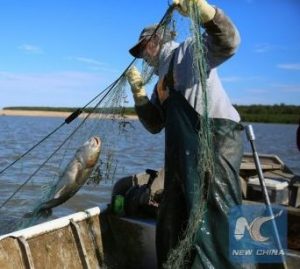
‘War on Carp’ – U.S. Sen. Mitch McConnell’s message is help is on the way
McConnell said the focus of the interested parties is catching the Asian carp, marketing the fish and reducing the population so they no longer threaten bass fishing and tourism.,,, Marshall County Commissioner Kevin Spraggs, spearheading the Marshall County War on Asian Carp Working Group, said overall the information presented during the hour-long meeting was “very promising.” “I’m very, very encouraged today. We have the right people, the right experts working on it and there’s talk of subsidies to help get more commercial fishermen involved and Senator McConnell is aggressively working on funding,” he said. >click to read<

Army Corps approves $778M plan to block Asian carp advance
The head of the Army Corps of Engineers has sent Congress a $778 million plan to fortify an Illinois waterway with noisemakers, electric cables and other devices in the hope that they will prevent Asian carp from reaching the Great Lakes, where the aggressive invaders could leave other fish with too little to eat. The plan represents a compromise between proposals to erect barriers that would seal off Lake Michigan from the river and less drastic measures such as stepped-up commercial fishing.>click to read<09:14

Luciano: Could Asian carp help a desperate Maine lobster market?
Officials in Illinois and Maine hope to soon announce a breakthrough that in both states could help solve aquatic challenges and boost economics. The news could especially bring a boon to central Illinois. In Illinois, invasive Asian carp choke the Illinois River. In Maine, the lobster industry faces a crisis for a sudden lack of lobster bait. If all goes well, commercial fishers in Illinois soon could be harvesting and shipping tons of Asian carp to Maine. >click to read<
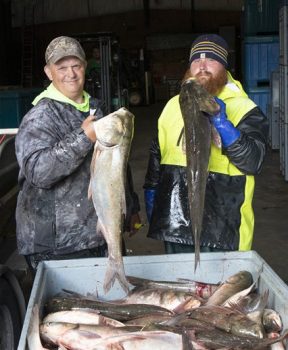
Asian carp lure Chinese investors (and Commercial Fishermen) to Kentucky
Justin Irwin and James Berry took turns to steer their boat on Barkley Lake in western Kentucky, looking for Asian carp.,,, Berry and Irwin, half-brothers originally from Washington, came to Kentucky to fish for Asian carp in November. Irwin is a commercial fisherman who has worked all over the world, most recently in Alaska during the summer. For three months, he worked 20 – to 22-hour days in Alaskan waters.,,, One day, Irwin read an internet article about Asian carp and commercial fishing in Kentucky, and immediately became interested. “As a commercial fisherman, I aim to fish as much as I can,” he said. >click to read<12:42

Canada closer to allowing Asian carp as lobster bait, depending on test outcomes
The Canadian Food Inspection Agency says it is prepared to accept invasive Asian carp from the United States as bait for the lobster industry, provided U.S. authorities can meet a number of conditions including proof the carcasses pose no disease threat. “If the U.S. can meet these requirements, Canada is willing to accept the import of dead, eviscerated silver carp for use as bait,” CFIA spokesperson Brian Naud said in a statement. There is interest in both countries in using Asian carp to supply their respective lobster fisheries which are experiencing a bait shortage as traditional sources decline: herring in the United States and mackerel in Canada. The state of Maine is poised to make a decision on Asian carp as a bait source by the end of May. >click to read<11:34
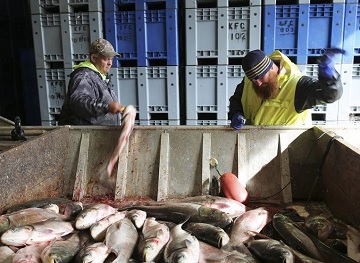
Spotlight: First Asian carp industrial park in U.S. heralds triumph over invasive fish
The birth of an industrial park devoted to Asian carp processing in the southeastern U.S. state of Kentucky has added to hopes that its prowess in turning the bony fish into delicacy increases the odds of winning the battle against the invasive fish in the Mississippi River. On April 12, the International Fisheries Industrial Park, sitting on 64 acres of wooded land in Wickliffe City, Ballard County, came online. With the newly arrived Chinese makers of fish ball, smoked fish, dried fish, fish sauce and a manufacturer who turns fish guts into organic fertilizers, the industrial park achieves vertical processing integration and is waste-free. (a possible new lobster bait source!) >click to read<13:59
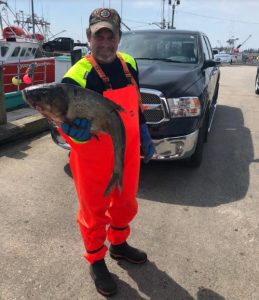
Canada says no to Asian carp as lobster bait
The Canadian Food Inspection Agency is throwing cold water on the prospect of importing Asian carp from the United States for use as lobster bait.
With bait prices on the rise, the invasive species was promoted as a cheaper bait source for the lucrative fishery. “The CFIA is aware that the industry has expressed interest in importing Asian carp for bait for the lobster fishery,” agency spokesperson Christine Carnaffan said in an email. The position is news to promoter Patrick Swim of lobster.ca, who said he has spent months seeking permits from both countries to import Asian carp from the Illinois River as bait for the lobster fishery in southwest Nova Scotia and Maine. >click to read<08:46

Federal help potentially coming to help fight the War On Carp
The war on Asian Carp is nowhere close to being over. Lyon County Judge Executive Wade White just returned from Washington D.C. and says help could be on its way. During that trip, White requested 12 million dollars in funding. White says that money will go toward Asian Carp barriers at nine different hot spots on the lake, subsidies for fisherman, and research on carp control methods. Also in the works – a change to fishing restrictions that would allow commercial fisherman to fish on the weekends to help catch more Asian Carp. Current regulations restrict them from doing that. >click to read<11:31
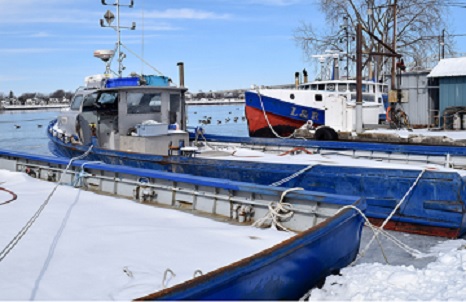
Lake Huron – Thriving family fishery spans 2 centuries, 5 generations
Tim Purdy gets a little emotional when he talks about his son Josiah becoming the fifth generation to work at the family fishery in Point Edward. “It’s good to see your kids want to be involved,” Purdy says. Though proud his son is part of a thriving business that’s operated for nearly 120 years, he’s worried too. “We’re trying to figure out how to stop the Asian carp,”,,, >click to read< 18:07
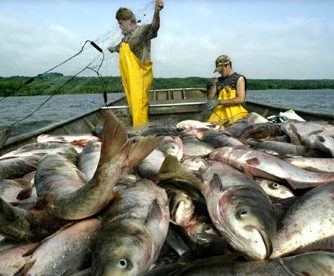
Illinois to Michigan: Put your money where the carp is
Gov. Bruce Rauner said today that Illinois is happy to accept $8 million from the State of Michigan to put toward the fight to keep Asian carp out of the Great Lakes — provided the funds can be used now to advance the effort. Unfortunately, Michigan Gov. Rick Snyder’s current offer of financial assistance isn’t applicable until 2028. Rauner sent a letter today to Snyder with a counterproposal to continue the fight against Asian carp. The Illinois governor said the best way to reduce the risk of Asian carp invasion is to enhance commercial fishing strategies in the Upper Illinois River and the Alton, LaGrange and Peoria pools today. >click to read<12:37
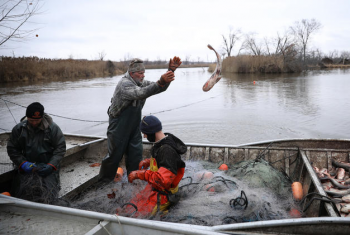
‘Carp cowboys’ round up invasive Asian carp as Illinois, federal officials debate costly measures to protect Lake Michigan
In Illinois, current strategies have successfully reduced the leading edge of the Asian carp population by 93 percent since 2012, according to sonar scans. By removing more than 1 million pounds of carp annually in the past several years, the state has contained the adult population to the Dresden Island Pool, 47 miles away from Lake Michigan, near Minooka, Ill. But computer modeling suggests it’s not enough. To repel Asian carp, about four times that amount needs to be removed from downstream.,, On Tuesday, near the banks of Sheehan Island where Asian carp like to take refuge, state-contracted fisherman Shawn Price gunned the engine of his boat while his father hit a wooden stick on the side. Minutes later, Shawn Price began pulling in nets chock-full of Asian carp. >click to read<09:01
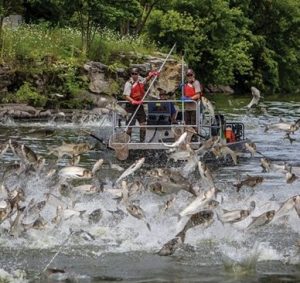
Pricetag of Asian Carp Defense Project Climbs to $778 Million
The forecasted pricetag of a planned Asian carp defense system near Joliet, Illinois that would hopefully prevent the invasive species from infiltrating the Great Lakes has now climbed to $778 million, up from an initial estimate of $275 million, according to an update last week from the U.S. Army Corps of Engineers. As reported by the Detroit News, the project, which would be finished sometime between 2025 and 2027, will now be reviewed by state and federal agencies. If Congress funds the initiative, an electric barrier would be installed as well as underground speakers to essentially blast noise at fish to stop them in their tracks northbound. >click to read<12:12










































